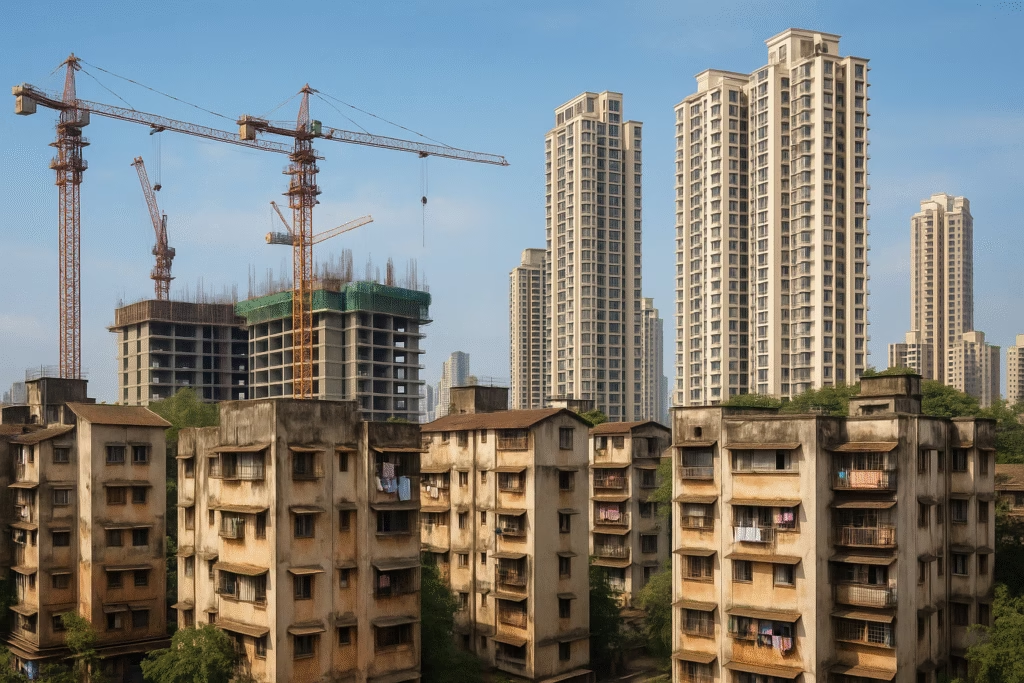Mumbai’s urban transformation hinges significantly on the redevelopment of old and dilapidated buildings, especially in the Island City. One of the most impactful urban renewal policies is Regulation 33(7) under DCPR 2034, which enables the redevelopment of cessed buildings—structures built before 1969 and classified as unsafe or unfit for habitation. This article explores the core aspects of DCPR 33(7), including its FSI incentives, eligibility, and the ideology behind Section 33(7) redevelopment.
What Is DCPR 33(7)?
Regulation 33(7) of the Development Control and Promotion Regulations (DCPR) 2034 allows for the redevelopment of cessed buildings in Mumbai’s Island City. These buildings, which are over five decades old, fall under the control of MHADA and are eligible for redevelopment when deemed structurally unsound.
The rule facilitates private developers or cooperative societies to redevelop these plots by offering rehabilitated homes to tenants and saleable components to developers using additional FSI (Floor Space Index).
Redevelopment of Cessed Buildings in Mumbai
Cessed buildings refer to structures that pay a repair cess to MHADA and were constructed before September 30, 1969. Most are chawls, tenements, or old residential buildings with extremely poor infrastructure.
Redevelopment under DCPR 33(7) allows these buildings to be transformed into modern towers, improving living conditions for thousands of tenants while unlocking commercial potential for developers. The key is to balance tenant welfare with economic viability.
FSI Incentives Under DCPR 33(7)
To make redevelopment financially feasible, DCPR 33(7) offers generous FSI incentives, including:
- FSI of 3.0, or rehabilitation area + 50% incentive (whichever is higher).
- In composite redevelopment (multiple adjacent plots):
- Rehab + 60% incentive FSI for 2–5 plots.
- Rehab + 70% incentive FSI for 6+ plots.
- Additional fungible FSI of up to 35% may apply.
- Each tenant is guaranteed a minimum carpet area of 300 sq. ft., with bonuses available.
This flexible approach ensures tenants are not only accommodated but often receive upgraded, larger homes.
Section 33(7) Cess Buildings Ideology
The ideology behind Section 33(7) is deeply rooted in social welfare, urban renewal, and safety:
- Preservation of tenants’ rights: Tenants cannot be evicted without alternative accommodation and are entitled to upgraded homes.
- Incentivized private participation: Developers are motivated through FSI and fungible area incentives.
- Urban renewal: It replaces crumbling infrastructure with modern, regulated, and safer residential complexes.
- Reduced burden on public housing agencies: By involving private players, the state reduces its financial responsibility while regulating the process.
The regulation envisions a win-win for tenants, developers, and the city.
Challenges in Implementation
While the framework is robust, several challenges persist:
- Delays in MHADA/NOC approvals
- Consent issues among tenants (though now reduced to 51%)
- Disputes over developer selection
- Financial feasibility in smaller plots
Proper planning, transparency, and timely regulatory clearances are essential for success.
Conclusion
DCPR 33(7) is one of the most progressive and tenant-focused redevelopment policies in India. By addressing both social and urban infrastructure concerns, it brings long-overdue transformation to Mumbai’s aging housing stock. With the right execution, it holds the promise of a safer, cleaner, and more organized Mumbai.
⚖️ Disclaimer:
The information provided in this article is for general informational purposes only and is based on publicly available regulatory data under DCPR 2034. It does not constitute legal advice, architectural guidance, or professional recommendation. Readers are strongly advised to consult with a qualified legal advisor, licensed architect, or urban planning expert before making any decisions related to redevelopment projects under Regulation 33(7). Relying solely on this article for any redevelopment action may result in compliance issues or unintended consequences.

